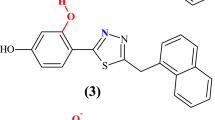Abstract
Spectral studies of the interaction between amanitine and ethidium bromide fluorophore showed the appearance of a new intensive fluorescence band after addition of amanitine to ethidium bromide solution, caused by the formation of a charge-transfer complex. The new fluorescence band is located in a shorter wave region of the spectrum compared to ethidium bromide fluorescence band. Based on the results, a rapid fluorescent method for detection of amanitines was developed.
Similar content being viewed by others
References
L. S. Gurevich, I. K. Zhurkovich, and E. L. Nezdoiminogo, Mikologiya i Fitopatologiya, 29, 32–39 (1995).
J. R. Lakovich, Principles of Fluorescence Spectroscopy, 2nd ed., New York (1999).
B. Valeur, New Trends in Fluorescence Spectroscopy: Applications to Chemicals and Life Sciences, New York (2001).
Author information
Authors and Affiliations
Additional information
__________
Translated from Byulleten’ Eksperimental’noi Biologii i Meditsiny, Vol. 141, No. 1, pp. 119–120, January, 2006
Rights and permissions
About this article
Cite this article
Vlaskin, D.N., Gainullina, E.T., Klyuster, O.V. et al. Express method for detection of Amanita phalloides amanitine toxins. Bull Exp Biol Med 141, 110–111 (2006). https://doi.org/10.1007/s10517-006-0107-2
Received:
Issue Date:
DOI: https://doi.org/10.1007/s10517-006-0107-2




